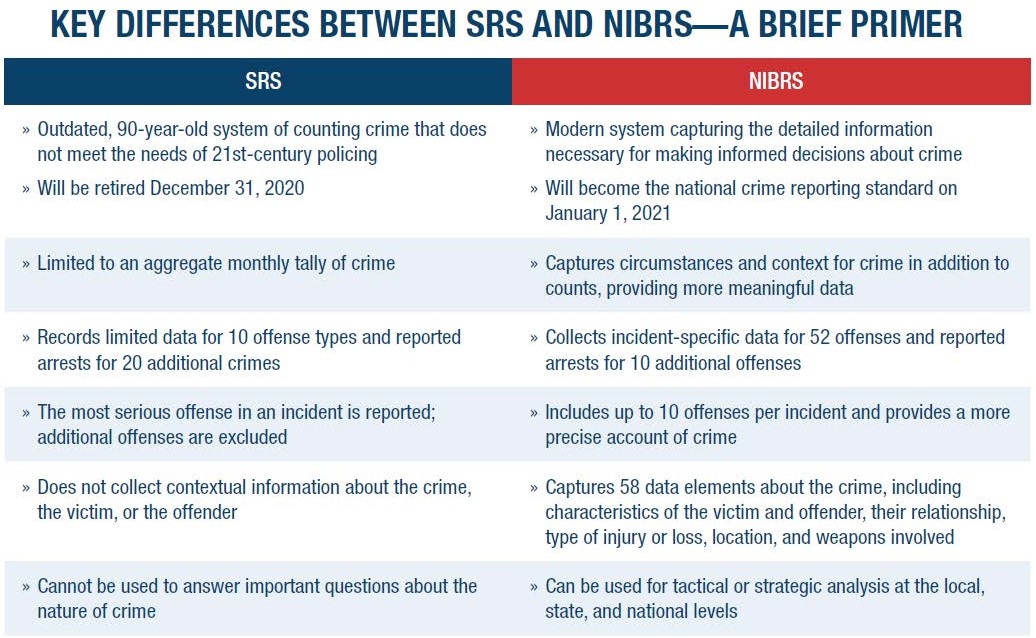Until January 1, 2021, the United States’ primary measure of crime known to law enforcement was monthly counts of ten offense categories—murder and nonnegligent manslaughter, rape, robbery, aggravated assault, burglary, larceny-theft, motor vehicle theft, arson, human trafficking-involuntary servitude, and human trafficking-commercial sex acts—based on the most serious offense reported for each crime incident. NIBRS was implemented in the late 1980s to improve the overall quality of crime data collected by law enforcement by capturing details on each single crime incident—and on separate offenses within the same incident—including information on victims, known offenders, relationship between victims and offenders, arrestees, and property, weapons, and/or drugs involved in crimes.
When NCS-X was designed in 2010, only about 25% of the nation’s roughly 18,000 law enforcement agencies contributed data to NIBRS. While the data collected through NIBRS was ideal for the NCS-X, agency participation rates did not meet minimum requirements for quantifying crime at the national-level. BJS determined it could produce national estimates of NIBRS data by enrolling a scientifically selected sample of 400 law enforcement agencies to submit data in addition to the agencies already participating in NIBRS.
In 2013, BJS and the FBI partnered on NCS-X and began working to expand NIBRS coverage through funding, training, and technical assistance to law enforcement agencies. The partnership leveraged the FBI’s existing NIBRS program infrastructure, allowing the two agencies to, (1) promote NIBRS data collection among the state Uniform Crime Reporting (UCR) programs, and (2) recruit the 400 NCS-X law enforcement agencies and support their transition to NIBRS.
State-Level Expansion of NIBRS
NCS-X funding and assistance were provided to two types of state entities--state UCR Programs and State Administering Agencies (SAA). In order to expand NIBRS reporting nationally, the NCS-X worked with state UCR Programs to ensure they were “NIBRS certified,” meaning the program demonstrated it was capable of collecting and processing NIBRS-compliant data from state and local law enforcement agencies and could transmit those data to the FBI. State-level NCS-X funding served two general purposes, to (1) help state UCR Programs upgrade or procure NIBRS-compliant data repositories and other software, hardware, or equipment necessary for improved data automation and transmission, and (2) expand incident-based reporting within the state by partnering with SAAs to administer subawards to state and local agencies selected into the NCS-X sample of 400.
As of April, 2022, all state UCR Programs were certified by the FBI to collect and submit NIBRS data. As of February, 2022, 11,525 law enforcement agencies were reporting to NIBRS, comprising 61.2 percent of all crime-reporting law enforcement agencies covering 64.5 percent of the U.S. population.
Local Agency Recruitment and Transition to NIBRS
Members of the NCS-X Technical Assistance and Implementation Team (NCS-X Team) worked directly with NCS-X selected agencies to identify gaps in their ability to report incident-based data. As part of recruitment activities, the NCS-X Team conducted Readiness Assessments to identify transition needs and associated costs to successfully collect and report compliant incident-based data. Funding was provided to improve data automation and reporting, with most eligible agencies receiving funds to obtain a NIBRS-compliant records management system (RMS) or other software, hardware, or equipment necessary to report to NIBRS. The NCS-X Team regularly met with award recipients to offer project guidance and technical assistance.



